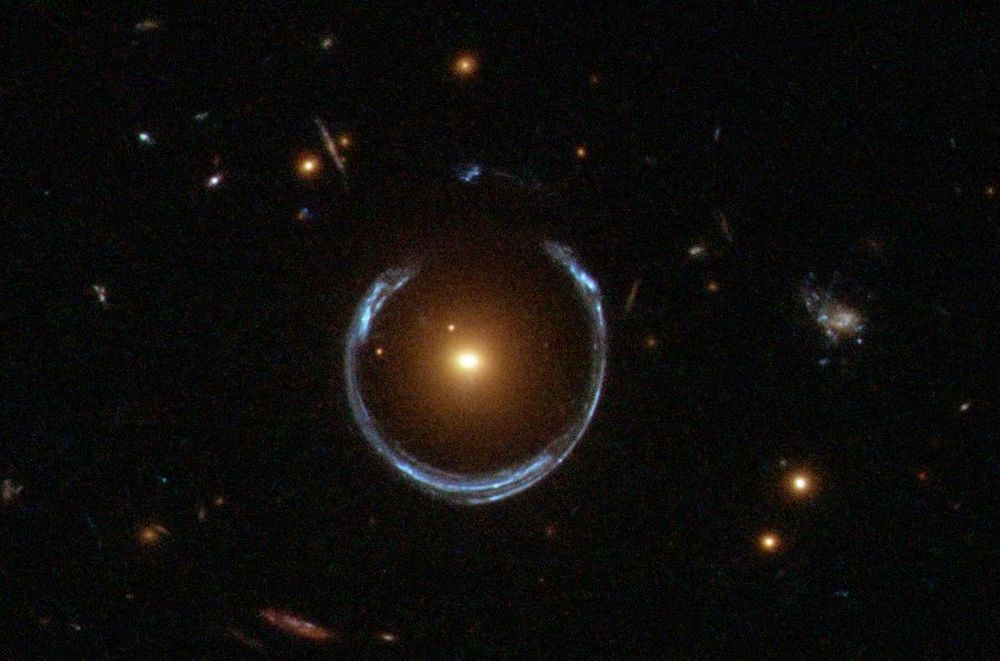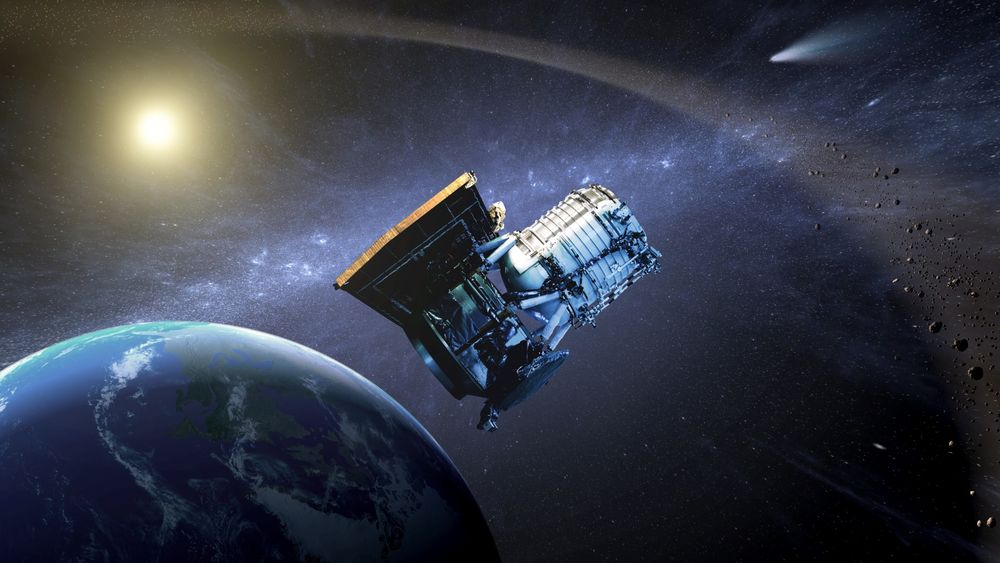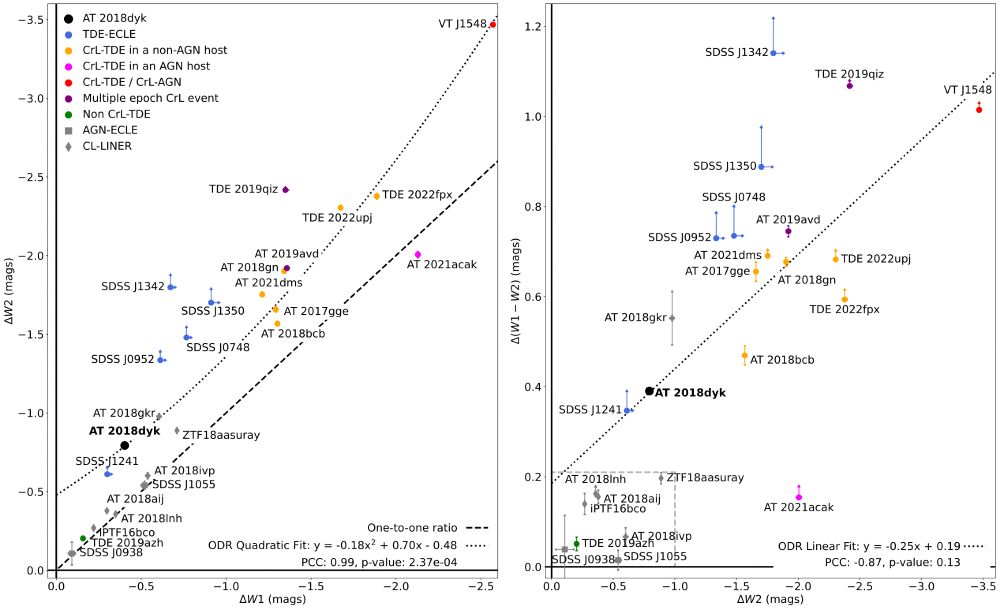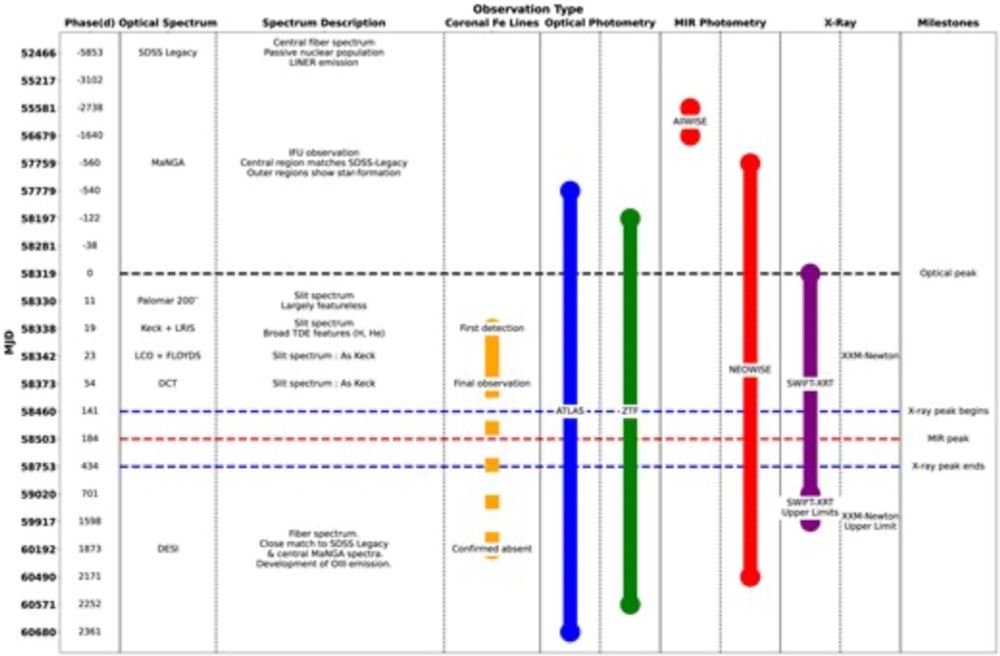
The VISTA 4MOST, a large, intricate astronomical device, housed inside an industrial facility. The structure features a prominent circular component with visible wiring and metal framework, supported by a sturdy blue frame with stairs and a raised platform for access.

The VISTA mountain top observatory stands on rocky terrain under a clear night sky, with the Milky Way stretching across and a bright planet shining above.
Revolutionary new space telescope @4most-eu.bsky.social has captured its first data from the universe.
Our scientists are part of the team behind the super-scope and say it’ll reveal how galaxies and black holes formed.
Read more 👉 tr.ee/ba4NEs
22.10.2025 08:46 — 👍 18 🔁 7 💬 1 📌 0

'Most massive black hole ever discovered' is detected
Astronomers have discovered potentially the most massive black hole ever detected. The cosmic behemoth is close to the theoretical upper limit of what is possible in...
Researchers at the University of Portsmouth and UFRGS in Brazil say the cosmic behemoth is close to the theoretical upper limit of what is possible in the universe and is 10,000 times heavier than the black hole at the centre of our own Milky Way galaxy.
Read more at: ras.ac.uk/news-and-pre...
07.08.2025 13:56 — 👍 26 🔁 14 💬 2 📌 2
YouTube video by The News Agents
The secret court that silenced the News Agents...until now
Two governments took The News Agents to secret court for two years via a constitutionally unprecedented superinjunction to stop you from hearing this story.
The MoD is responsible for a data leak that put up to 100,000 Afghans at risk of death.
www.youtube.com/watch?v=Zdc6...
15.07.2025 11:28 — 👍 924 🔁 428 💬 49 📌 46
Congrats Vicky! 😄
23.06.2025 12:24 — 👍 0 🔁 0 💬 0 📌 0
An Emerging Risk To #RadioAstronomy 📡
Using a prototype SKA-Low instrument, a new analysis from @icrar.bsky.social has detected Starlink signals leaking into protected radio bands.
@cosmicrami.com writes about this new study.
www.spaceaustralia.com/news/emergin...
📸 Astro_Work 🔭
#SpaceAustralia
05.06.2025 22:13 — 👍 282 🔁 118 💬 6 📌 17
Didn't have this level of political chaos on the bingo card today 👀
05.06.2025 20:44 — 👍 0 🔁 0 💬 0 📌 0
Thanks for reading!
Very happy to answer any questions you might have on this or the paper itself ☺️
30.05.2025 13:55 — 👍 2 🔁 0 💬 0 📌 0

Artist's impression of the WISE spacecraft in orbit.
Credit: NASA/JPL-Caltech
MIR observations are a powerful tool in helping to break the degeneracies between these groups.
On a final note, the MIR observations were made by favourite telescope WISE, which was decommissioned and burned up in Earth's atmosphere last year after more than 14 years of data gathering. 🫡
30.05.2025 13:55 — 👍 2 🔁 0 💬 1 📌 0
There is a lot more in the paper about the analysis and sample comparisons, but this thread is already feeling like another paper so I will end it here 😅
To conclude!
AT 2018dyk is fascinating TDE that occurred in a gas rich environment.
Telling TDEs apart from AGN flares is *not* an easy job
30.05.2025 13:55 — 👍 2 🔁 0 💬 1 📌 0
all had small and relatively 'blue' outbursts.
This is an indication that the different classes of object have environmental differences - perhaps differing amounts of gas/dust or configurations.
I'll be extending and refining this analysis with more objects going forward so stay tuned!
30.05.2025 13:55 — 👍 2 🔁 0 💬 1 📌 0
outbursts in the longer wavelength (redder) MIR band tend to be brighter than in the shorter wavelength (bluer) band.
This is also confirmed (those limited by the small number statistics) by those TDEs with redder outbursts also having larger outbursts. Whereas the changing look AGN we explored
30.05.2025 13:55 — 👍 2 🔁 0 💬 1 📌 0
I *strongly* advise those interested in the details to read the paper, but in summary.
Changing look AGN outbursts follow a 1-to-1 relation in their peak changes in luminosity in the two WISE bands.
TDEs showing the high energy iron emission lines don't follow this relation. Instead, their
30.05.2025 13:55 — 👍 2 🔁 1 💬 1 📌 0

A two panel figure showing the differences in mid-infrared outburst behaviour between TDEs showing high energy emission lines and changing look AGN.
Left: Changing look AGN closely follow a 1-to-1 relation between their peak changes in brightnesses in the two WISE bands. TDEs showing high energy emission lines in contrast deviate from this, with their outbursts significantly larger relative to their original brightness in redder of the two bands. Right: Those high energy TDEs showing large outbursts also show redder outbursts in the MIR. This is not the case for AGN.
the MIR behaviour these objects could be used to help tell them apart in a consistent way.
In short - yes it can! Though a lot more work and observations will be needed to tie down the specifics.
Enter this plot:
30.05.2025 13:55 — 👍 2 🔁 0 💬 1 📌 0
If this sounds familiar from how the iron and OIII lines are generated, that's because its the same processes involved. Just at a lower energy regime.
As TDEs and AGN related flares are still hard to tell apart - and alas not every galaxy has MaNGA data to help with this - I started to wonder if
30.05.2025 13:55 — 👍 2 🔁 0 💬 1 📌 0
in this case is rich in gas because we see a significant flare in the mid-infrared (MIR) at the time following 18dyk's optical detection. Such MIR flares occur when the optical and UV photons thrown out by a TDE get absorbed by nearby material and then reradiated at longer wavelengths over time.
30.05.2025 13:55 — 👍 2 🔁 0 💬 1 📌 0
is a less extreme version of this where material at greater distances (or lines of sight) from the SMBH is responding to the increased flux produced by the TDE. We will have to revisit the galaxy in a few more years to see how this emission has evolved.
We also know that the region around the SMBH
30.05.2025 13:55 — 👍 2 🔁 0 💬 1 📌 0
TDEs release a lot of high energy photons which can ionise and affect the gas close to the SMBH. We see this in the earlier spectra of 18dyk around its peak brightness which have highly ionised iron emission lines. These lines are only generated in the presence of X-rays.
The delayed OIII emission
30.05.2025 13:55 — 👍 2 🔁 0 💬 1 📌 0
This, combined with the new spectrum closely resembling the original SDSS spectrum and with the light-curves (both optical an mid-infrared) of 18dyk behaving in a very transient manner (Flat -> Outburst -> Flat), strongly point to 18dyk being a TDE.
What about the increased OIII emission though? 👀
30.05.2025 13:55 — 👍 2 🔁 0 💬 1 📌 0
region of the galaxy each, and all obtained simultaneously.
This allowed us to perform a much more in-depth analysis of how these emission lines are being produced - with this indicating that the emission lines prior to 18dyk being produced by evolved stars rather than AGN activity.
30.05.2025 13:55 — 👍 2 🔁 0 💬 1 📌 0
Strong OIII emission is usually a sign of AGN activity, but its more complicated than that as emission lines can be generated my multiple different processes.
To investigate further we also explore archival MaNGA data of the galaxy, which in essence consists of many spectra each covering a small
30.05.2025 13:55 — 👍 2 🔁 0 💬 1 📌 0
18dyk's host galaxy doesn't make this easy as its previous (before 18dyk occured) emission line behaviour classifies it as a Low-ionization nuclear emission-line region (LINER) which can be produced by either a relatively 'weak' AGN or emission from evolved stars unrelated to a SMBH.
30.05.2025 13:55 — 👍 2 🔁 0 💬 1 📌 0
This shows us that whatever the process that generated 18dyk was, its not an ongoing one, with the host galaxy having returned close to its original state.
I say *close* to because the spectra don't match exactly - the more recent DESI spectrum has much stronger OIII emission than the SDSS spectrum
30.05.2025 13:55 — 👍 2 🔁 0 💬 1 📌 0
This spectrum is particularly interesting as we can now explore what the host galaxy is doing now that 18dyk itself has faded away.
We first compared this new spectrum to an archival spectrum obtained by the SDSS years before 18dyk was seen to outburst. With the two looking remarkably similar.
30.05.2025 13:55 — 👍 2 🔁 1 💬 1 📌 0
We decided to explore a new spectrum of the galaxy that hosted 18dyk obtained by the Dark Energy Spectroscopic Instrument - DESI which you may be familiar with from its recent cosmology results : newscenter.lbl.gov/2024/04/04/d...
30.05.2025 13:55 — 👍 2 🔁 0 💬 1 📌 0
AGNs are similar to TDEs, as they are SMBHs messily 'eating' a load of material, but AGN are fuelled by ongoing processes rather than single events of material in a TDE.
Finally additional analysis reclassified 18dyk back to being a TDE. The confusion coming about by the similar processes in both.
30.05.2025 13:55 — 👍 2 🔁 0 💬 1 📌 0
AT 2018dyk has been responsible for quite a lot of confusion over the years. First being classified as a tidal disruption event (TDE: where a star passes too close to a supermassive black hole - SMBH - and gets torn apart), then reclassified as an active galactic nucleus or AGN
30.05.2025 13:55 — 👍 2 🔁 0 💬 1 📌 0
Hey everyone! Its time for a paper thread! My first here on Bluesky 😁
This time on the weird and wonderful transient AT 2018dyk 😎
You can read along in this thread, or if you'd prefer to get straight to the paper you can find it ...
Via MNRAS: academic.oup.com/mnras/articl...
30.05.2025 13:55 — 👍 5 🔁 5 💬 1 📌 1
Vaccines do not contain any fetal tissue or cells, nor do they contain any cells derived from fetal materials.
01.05.2025 03:18 — 👍 2583 🔁 720 💬 119 📌 42
Magazine editor living in Sheffield
Science communicator, video maker, author, podcast creator. PhD in theoretical atmospheric physics. Born at 354 ppm.
Ambassador for @coolearthaction
https://linktr.ee/simonoxfphys
Husband. Dad. Traveler. Avid reader. Shakespeare. Poe. Stephen King. Tolkien. Joe Abercrombie. Landscape gardener. Democracy lover. Cat lover. Music lover. Nature lover. Very amateur photographer. Birder. Treehugger. Hiker. Love over hate.💙
Dog Worshipping, Mountain Loving, Useless Solivigant. Environment is my highest priority. I’m PETRIFIED about overpopulation/overshoot. There are way too many people-most consuming way too much!
I desperately wish that Women were in charge! (I’m NOT one😏)
Prof. in Astronomy & Associate Dean EDI @Uni.Southampton. Quasars and galaxies research. Diversity & inclusion in academia. Science mum.
Official account of the LIGO Scientific Collaboration. We detect gravitational waves!
Email: questions@ligo.org
Associate Lector Sustainability Transitions | Sustainability education 🌱| Public Admin scientist | EU 🇪🇺 political & public affairs specialist| Historian | mother | feminist | cold water lover 💦 @inholland & @dehaagse
Astronomy & Astrophysics PhD student at the Australian National University. Working on cosmology with Type Ia supernovae and their host galaxies.
Physics, Space, Quantum Computing | BTC: bc1qqu05pu3rdqjchnh37mtylrgprkk94udc3g3umj
https://thephysicsjournal.substack.com
Independent game developer making RimWorld. We love deep PC games and story generators.
RimWorld: rimworldgame.com
Website: ludeon.com
Astronomer, husband, father, staff of cats, sometime trombonist
‘Mature’ student at the OU studying astronomy ‘we’re all in the gutter but some of us are looking at stars’
#SaintsFC fan, lager enthusiast
🇮🇪 🇵🇸
Slava Ukraini 🇺🇦
Astronomy postdoc at the University of Oslo, studying galaxy evolution and Active Galactic Nuclei
Astronomer. Writer. Educator. ADHD. Reader. Science Communicator. 🏳️🌈
New submissions in arXiv
Category: Astrophysics
https://arxiv.org/list/astro-ph/new
Administrator: krypf @krypf.bsky.social
lit link: lit.link/krypf
The Gravitational-wave Optical Transient Observer (GOTO) Network: identifying the optical counterparts to gravitational wave events. http://goto-observatory.org
Freelance science writer, mostly astro, some natsec sci, some women-in-astro, some grief psych, otherwise whatever I can get paid to write about. I love Baltimore, I do.
Official announcements and information about the Astronomy feeds.
This is a semi-automated account managed by @emily.space.
Website: https://astronomy.blue | GitHub: https://github.com/bluesky-astronomy








